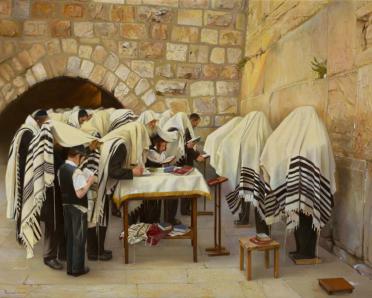Every week, parshaoftheweek.com brings you a rich selection of material on parshat hashavua, the weekly portion traditionally read in synagogues all over the world. Using both classic and contemporary material, we take a look at these portions in a fresh way, relating them to both ancient Jewish concerns as well as cutting-edge modern issues and topics. We also bring you material on the Jewish holidays, as well as insights into life cycle rituals and events...
This week’s parsha, Naso, contains the commandment to the Cohanim – the priests – to bless the Jewish people. The text of the priestly blessing is well known – “May the Lord bless and protect you. May the Lord shine his countenance upon you and show you grace. May the Lord raise His countenance to you and give you peace.”
The Ba’al Haturim, whose commentary on the Torah focuses on word repetition, gematria (the numerical value of letters) and different types of acronyms (first letters as well as last letters of words), tells us that the words of this blessing hint at some of Judaism’s most basic and sacred individuals and concepts. For example: A few of God’s names – beyond the one mentioned explicitly three times – are hinted at in various ways. The first letter of each of the first three words – יברכך ה' וישמרך are י,י,ו, which, in gematria, adds up to 26, which is the value of God’s four-letter name, and the last letters of the three words – כ',ה',כ' – add up to 45, corresponding to the 45-letter name of God. Also implied in the blessings, in various ways, are the names of our forefathers, Avraham, Yitzchak, and Yaakov. The fifteen letters that make up the first of the three verses hint at the fifteen years that the three forefathers were all alive together.
The last word of the blessings is שלום – shalom, peace. The Ba’al Haturim tells us that the numerical value of the letters of the word שלום is the equivalent of the numerical value of the name עשו - Esau, the wicked son of Yitzchak, who lost his birthright and his blessings to the more worthy Yaakov. (The numerical value these words share is 376). Now, Esau is seen as an archetype of bad behavior and, specifically, anti-Semitism. The rabbis tell us that we know it to be axiomatic that Esau detests Yaakov. This is true not only during their lifetimes, as the Torah’s narrative tells us, but as an ongoing, historical model of specifically Roman/Christian Jew hatred. If this is the case, why in the world should the final, beautiful word of the priestly blessing – peace, שלום – call this wicked and problematic person to mind? How can Esau, the archetypal enemy of the Jewish people, be part of the blessing?
The Ba’al Haturim explains that the point of hinting at Esau at the end of the blessing with this gematria is to teach us that we should greet – say shalom – “to all people, even a non-Jew.” Esau, the non-Jew, the one who is constantly at odds with the Jewish people, is deserving of the wish for and blessing of peace; we are told to greet non-Jews with the blessing of peace which the priests bestow on us.
The idea that this ultimate, final blessing of peace is meant to be shared forward, beyond the Jewish community, to the world of Esav, is nothing short of revolutionary. The normative default position which Jewish tradition adopts towards Esau and his biological/ideological descendants is extremely negative. The question as to whether or not, and to what extent, we should behave politely and collegially towards them is discussed in the halacha (religious Jewish law). But this idea, that from the priestly blessing, which is the expression of God’s love and concern for the Jewish people, we are meant to take the final, ultimate blessing of peace, and pass it on, as it were, to non-Jews, is a remarkable expression of solidarity and brotherhood with the ultimate Jewish “other”. It goes way beyond the simple saying of a ‘hello, how are you?’ Derived, as it is, from this verse, it includes the non-Jew in the divine love and concern which are expressed in the blessings of the Cohanim; it brings the offspring of Esau, our traditional nemesis, into the orbit of God’s blessing for the Jewish people.
This gematria teaches us that the final, ultimate, expression of God’s blessings, especially the greatest of them all, peace, is to pass those blessings along, beyond the circle of those whom we would obviously and automatically bless, to those who, were it not for this drasha, we would perhaps never think to bless at all.
Shabbat Shalom,
Rabbi Shimon Felix



Get inspired by Naso Divrei Torah from previous years